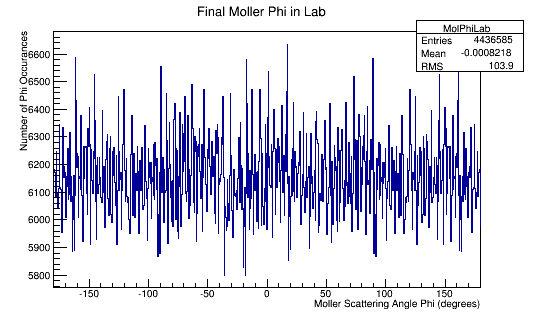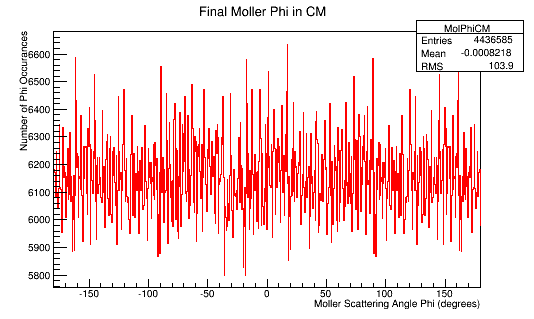Alter Phi Angles
From a C++ program, random Energies and Angle Theta are read from the 2-D histogram created above. Using Relativistic kinematics for CM frame, a 4-momenta vector for the Moller electron is created. Using the properties of the CM frame, a 4-momenta vector for the scattered electron is created. Using the relative counts for number of events at a given angle theta in the CM frame, multiple copies of the Moller CM 4-momenta vector are created. Since the rotation of the angle Phi does not alter the z or total momentum, the same paired version of the scattered electron 4-momenta vector are transfered over from the Moller. Altering Phi Angles
Using two paired 4-momenta vectors in the CM frame, we can rotate them from the "CM-final" state to the "CM-initial" state by having the total momentum of each vector being held only in the z-component as would be expected for two colliding particles (). From this, a Lorentz boost can be performed to find the 4-vectors in the Lab frame for an incoming electron or various energies striking a stationary electron. With the boost vector a second Lorentz boost can be performed from the Final CM Frame to the Final Lab Frame. In this state, the phi distribution is unaffected by the Lorentz boost (perpendicular to direction of relativistic motion), while the theta angle is transformed.
10 separate trials were run for 10,000 events each. The histograms of Momentum, Angle Theta and Phi for the scattered and Moller electron in both the final lab frame and final CM frame were combined using:
hadd -f Total_MakeCM_4e9.root set1/MakeCM_4e9.root set2/MakeCM_4e9.root set3/MakeCM_4e9.root set4/MakeCM_4e9.root set5/MakeCM_4e9.root set6/MakeCM_4e9.root set7/MakeCM_4e9.root set8/MakeCM_4e9.root set9/MakeCM_4e9.root set10/MakeCM_4e9.root
The Phi distribution for the CM and Lab frame.
Their LUND files were combined using
cat set1/Extra_Phi.LUND set2/Extra_Phi.LUND set3/Extra_Phi.LUND set4/Extra_Phi.LUND set5/Extra_Phi.LUND set6/Extra_Phi.LUND set7/Extra_Phi.LUND set8/Extra_Phi.LUND set9/Extra_Phi.LUND set10/Extra_Phi.LUND >Total_Extra_Phi.LUND
resulting in a LUND file that was 13309755 lines in length, which equates to 4436585 entries. This was divided into 177 file parts of 75000 each. The first set from the original data set is shown below.
split -a 4 -d -l 75000 Total_Extra_Phi.LUND Phi_Parts_


